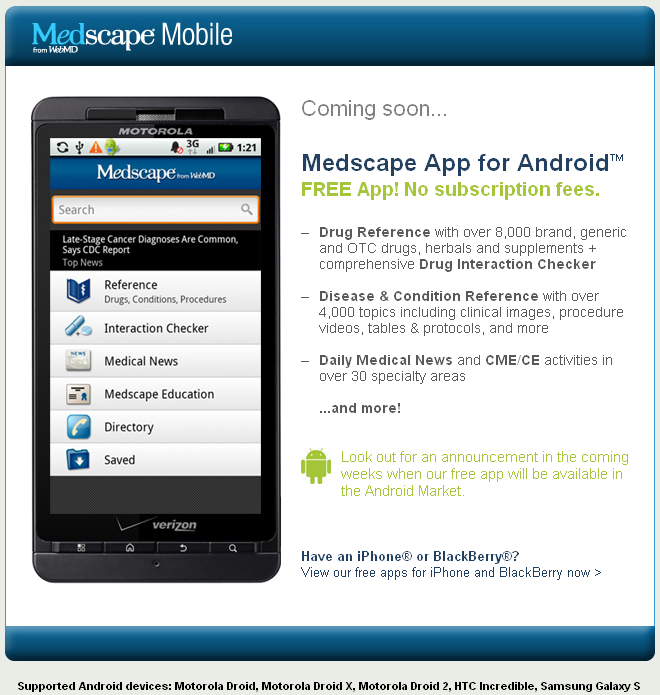If you haven’t heard of the Google body browser, then you’re really missing out. Google body browser is an incredible in-browser 3D rendering of the human body. It offers individual anatomic layers of the skin, muscles, bones, vascular system, nervous system and organ system. The various layers can be selected or deselected as desired while offering even more flexibility by allowing the user to make any of the selected anatomic layers transparent. Truly amazing. I highly recommend giving it a try.
Blog
-
The state of mHealth – a survey from research2guidance
Over the summer I participated in research2guidance‘s online mobile health developers‘ survey.
In total there were 231 participating companies ranging from start-up mHealth specialists to traditional healthcare market players.
Basically the survey reveals that smartphothes, i.e. mobile devices, will have a significant impact on healthcare over the next few years. I don’t think anyone is surprised by this information, but it’s certainly nice to see validation in the form of a survey. Granted, surveys aren’t the best way to gauge whats happening in the market, but it’s better than nothing.
Some of the results of the survey are:
- Nearly 80% of respondents see diabetes as the therapeutic area with the highest business potential
- Almost 70% of survey participants agree that app developers and agencies will be the main players in the market
- Smartphone penetration is seen as the main driver for mHealth by 63% of respondents
- Lack of standardization (50%), regulation (49%) and market transparency (49%) are the main barriers facing mHealth
- Doctors and hospitals are seen as the best distribution channel for mHealth apps by 2015
- Android and iOS will be preferred mobile platforms for mHealth solutions
You can get a free copy of the basic results in the form of a whitepaper at the research2guidance website.
A more detailed report called “Global mHealth Market Report 2010-2015” can also be found at the research2guidance website, but you’ll have to open up your checkbook. As a participant I received a dicount code for the full report (10% discount code: 3EEX8QH). Enjoy.
-
Most read blog posts from last week (50)
Here’s a list of the top ten most read blog posts on this site from last week:
- First Impressions – Lenovo X201 Tablet PC
- Moving storage around in the “cloudâ€
- Cool Technology (September 19, 2009 – Capsule Machine)
- Best iPhone / iPod Touch Applications for Pharmacists
- Medscape Mobile for Android on its way
- Integration of medical device data into EMRs
- Automated unit-dose packagers for acute care pharmacy
- Cool Technology for Pharmacy (June 18,2009 – Alaris Smartpumps)
- To think outside the box you must first know what box you’re thinking in
- Cool Technology for Pharmacy – Pentapack HP500
- #AHSPMidyear, the end
- “What’d I miss?†– The week of December 12, 2010
- Biometric identification and facial recognition
- Pediatric labels for bar code medication administration (BCMA)
- Conference note taking with a tablet PC
-
The Johns Hopkins ABX Guide now available for Android, let the party begin
 I received an email recently notifying me of the availability of The Johns Hopkins ABX Guide for the Android OS. I remember using the Hopkins ABX guide on my Palm Pilot many years ago. The website has always been a great source of information and having it in a mobile platform is great, especially for pharmacists.
I received an email recently notifying me of the availability of The Johns Hopkins ABX Guide for the Android OS. I remember using the Hopkins ABX guide on my Palm Pilot many years ago. The website has always been a great source of information and having it in a mobile platform is great, especially for pharmacists.According to the email I received from the USBMIS Development Team: “The Johns Hopkins ABX Guide for Android continues to provide current, authoritative, comprehensive information on anti-microbial agents, infectious diseases, and commonly-encountered pathogens in one portable volume. Written by experts at the world-renowned Johns Hopkins University School of Medicine, this must-have resource features expert recommendations, clinical anddiagnostic decision-making tools, and drug-to-drug interactions. Concise, thorough, and current, The Johns Hopkins ABX Guide, Mobile Edition is designed for quick reference and comprehension. Information is featured in an easy-to-access format
 that facilitates rapid application of knowledge at the point of care.â€
that facilitates rapid application of knowledge at the point of care.â€Click this link on your Android device or simply scan the QR-Code to the right to download The Johns Hopkins ABX Guide. The application used to be free, but now it’ll lighten your pockets a bit with a $25 price tag.
-
Don’t dismiss the potential of Chrome OS just yet
The Cr-48 is Google’s first notebook sporting their Chrome OS. While the hardware is nice, it’s really the operating system and the concept that’s raising eyebrows and generating interest. The operating system is designed to make optimal use of “the webâ€. The features of Chrome OS include instant on, fast load times, cloud storage and recover, etc. A full list of features can be found at the Google Chrome OS website.
I’ve read several reviews of the Cr-48 and for the most part users haven’t been all that impressed. The reviews interest me because I don’t believe the people using these machines get it. First and foremost, the Cr-48 is clearly a work in progress as is Chrome OS. Second, the idea of an internet based, fully cloud enabled system is ideal for creating a hardware agnostic future. It appears to me that Google is testing the waters and collecting data for a future run at something bigger. Do you really doubt Google will continue to develop a better cloud concept for an operating system? It would be a mistake to do so.
I remember similar thoughts from the so called experts when the Android OS rolled out, and now it’s slowly becoming the most prominent operating system for mobile devices. I don’t see that changing anytime in the near future.
(more…) -
“What’d I miss?” – The week of December 12, 2010
It’s been a good week in the world of non-pharmacy. ASHP Midyear 2010 is behind us, but the work generated from that meeting has just begun. And as usual there were a lot of things that happened during the week, and not all of it was pharmacy or technology related. Here’s a quick look at some of the stuff I found interesting.
(more…) -
Cool Technology for Pharmacy – Pentapack HP500
 There really aren’t too many machines out there designed to unit dose liquids on a scale small enough for the needs of an acute care pharmacy in a hospital. So when I came across the Pentapack HP500 in the ASHP Midyear exhibit hall I took notice. As demonstrated at ASHP Midyear, the machine is capable of unit dosing both oral solids and oral liquid medications. That’s rather unique functionality that deserves some attention.
There really aren’t too many machines out there designed to unit dose liquids on a scale small enough for the needs of an acute care pharmacy in a hospital. So when I came across the Pentapack HP500 in the ASHP Midyear exhibit hall I took notice. As demonstrated at ASHP Midyear, the machine is capable of unit dosing both oral solids and oral liquid medications. That’s rather unique functionality that deserves some attention.Unfortunately the Pentapack website is void of useful information, which is really a shame because the HP500 is a neat little device.
(more…) -
To think outside the box you must first know what box you’re thinking in
I know you’ve heard it before; someone telling you to think outside the box. I know I’ve heard it a lot of times. It seems to be the catch phrase of choice when people want you to come up with a solution to a problem that no else can solve, or a problem where conventional wisdom doesn’t seem to be working.
I spent the last three days in San Francisco attending a pair of seminars put on by a company called Pragmatic Marketing. The first was a two day seminar titled “Practical Product Management†and focused on all the things an effective product manager should be doing. The second was a one day course titled “Requirements That Work†that spent time explaining the best way to move your product through a minefield from solving a market problem to getting your well defined solution designed, developed and shipped.
Overall the information was worthwhile. Because I’m new to the world of product management I was pretty much overwhelmed by the information because I have a lack of familiarity with everything from the verbiage to the business world. I looked around the room and noted how many heavy hitters in the technology world were represented, including RIM and HP. The thought hit me like a ton of bricks: these people are here to learn how to think inside the box. Let’s face it, the material was a well laid out roadmap of how to be a successful product manager. I always wonder how things like this get started. Someone made it big and everyone else decided that that was the right way to do things and started copying the process.
Several times during the three day course the instructor used the phrase “lather, rinse, repeatâ€. In other words create a process that is standardized and repeatable; interesting concept. This is the exact opposite of thinking outside the box. In fact, it is teaching every product manager to use the exact same box if they want to be a success. Is that the right approach? I have no idea. Obviously I’ll take what I’ve learned and try to apply it verbatim. I mean after all, I no idea what being a product manger is all about. I’ve been a pharmacist for the past 13 years and a product manager for three weeks. I really need someone to draw a box for me to work in. I’m just sayin’.
-
Most read blog posts from last week (49)
Here’s a list of the top ten most read blog posts on this site from last week:
- #AHSPMidyear, the end
- #ASHPMidyear rolls on
- #ASHPMidyear 2010 part deux
- Cool Technology for Pharmacy (June 18,2009 – Alaris Smartpumps)
- Automated unit-dose packagers for acute care pharmacy
- Best iPhone / iPod Touch Applications for Pharmacists
- “What’d I miss?†– The week of December 5
- Best iPhone / iPod Touch Applications for Pharmacists
- Moving storage around in the “cloudâ€
- Biometric identification and facial recognition
- First Impressions – Lenovo X201 Tablet PC
- #ASHPMidyear day one comes to an end
-
Medscape Mobile for Android on its way
Medscape was one of the first online medical communities with a specific section for pharmacists. It was also the first online medical reference site I registered to use back in 1997.
Anyway, Medscape Mobile has been available for the iPhone and BalckBerry devices for quite some time. I received an email today notifying me that it will soon be available for Android devices. This is exciting stuff.
The email content can be seen below.


